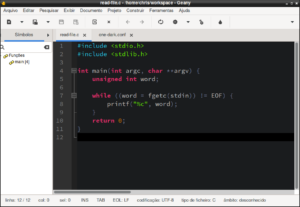This tutorial is for peoples that wants to install the Archlinux with a minimal desktop tools and utilities. I will consider that you is an Linux user and knows how to use the terminal and its tools. Archlinux is installed by command lines, so I’ll put here only the commands necessary to install the system. If you want to know more about these steps, so you can search the internet or use the man page of your Linux distribution. Let’s go!
Download the Archlinux and boot it on your computer. You can create usb bootable disk using the dd linux tool.
# dd if=archlinux.iso of=/dev/sdb status=progressReplace /dev/sdb with the path of your removable disk.
Archlinux installation
List your disks and get the path of hard disk that you want to install the system.
# fdisk -lMy hard disk path is /dev/sda, so to create the system partition scheme I have to run:
# cfdisk /dev/sdaI will use three partitions on my system. One for swap, other for system and other for home:
- /dev/sda1 is my swap partition
- /dev/sda2 is the system partition /
- /dev/sda3 is my home partition /home
Now we have to format the disk:
# mkswap /dev/sda1
# mkfs.ext4 /dev/sda2
# mkfs.ext4 /dev/sda3After partitioning the disk we have to mount that.
# mkswap /dev/sda1
# mount /dev/sda2 /mnt
# mkdir /mnt/home
# mount /dev/sda3 /mnt/homeMounting the home partition now is only required to generate de fstab configuration.
After creating the system partitions, formatting and mounting them, we be able to install the archlinux base system.
We need network connection to install the archlinux, so check your network configuration:
# ip aObtaining the automated IP configuration:
# dhclient <network adapter name>Connecting in the wi-fi network:
# wpa_passphrase wi-fi-network-name password > wifi.conf
# wpa_supplicant -B -i wi-fi-adapter -c wifi.conf
# dhclient wi-fi-adapterTest your network connection:
# ping archlinux.orgInstall the base packages:
# pacman -Sy
# pacman -S archlinux-keyring
# pacstrap /mnt base linux grubGenerate the fstab configuration:
# genfstab -U /mnt >> /mnt/etc/fstabSwitch to the new system:
# arch-chroot /mntConfiguring the new system
Configure the hostname and hosts files:
# echo archlinux > /etc/hostname
# echo "127.0.0.1 localhost" > /etc/hosts
# echo "::1 localhost" >> /etc/hostsSet the console keyboard map:
# echo "KEYMAP=us" > /etc/vconsole.confChange the system language:
Edit the /etc/locale.gen file and remove the # character of the line that contains your language, and apply the settings:
# locale-genInstall the grub bootloader:
# pacman -Sy
# pacman -S grub
# grub-install /dev/sda
# grub-mkconfig -o /boot/grub/grub.cfgSet the time and date:
# ln -sf /usr/share/zoneinfo/America/Sao_Paulo /etc/localtime
# hwclock --systohcReplace “America/Sao_Paulo” with your locale. You can search on zoneinfo directory to see more locales available.
Install a text editor to edit system config files:
# pacman -S nano vimInstall network tools:
# pacman -S wpa_supplicant dhclient net-toolsCreate a new user:
# useradd -m -U -G video,audio,power,storage,network,wheel,lp username
# passwd usernameNow we have a basic system with the tools needed to configure the network and edit the system files. If you reboot your computer now, you can enter on the new archlinux system.
If you want a minimal graphical system desktop, so make the following procedures. These next steps are optionally and you can replace the suggested software’s with the ones you like.
To run a graphical environment we need a graphical server, so we have to install the xorg packages:
# pacman -S xorg xorg-xinit xorg-commonInstall the minimal graphical environment packages:
# pacman -S openbox lxappearance lxappearance-obconf lxde-common lxinput lxlauncher lxlauncher lxpanel lxrandr lxsession lxterminal pcmanfmNow create the .xinitrc file to start the graphical environment:
$ echo "exec lxsession" > ~/.xinitrcAfter booting your system and authenticating, to start the graphical environment you have to execute the following command:
$ startxOur system is ready! But its needs some software’s for daily usage.
Install a web browser:
# pacman -S firefoxor:
# pacman -S chromiumImage viewer:
# pacman -S gpicviewCalculator:
# pacman -S galculatorWord processor:
# pacman -S abiwordTools for automated removable device mount:
# pacman -S gvfs fuse2 fuse3 libmtp gvfs-mtpTorrent download manager:
# pacman -S transmission-gtkCommand line download manager:
# pacman -S wgetInstall a firewall:
# pacman -S ufw
# ufw enableGraphical text editor:
# pacman -S mousepadVideo player:
# pacman -S mpvAdd support for multimidia:
# pacman -S gst-plugins-base gst-plugins-good gst-plugins-badSound server to listen audio:
# pacman -S alsa alsa-lib alsa-utils alsa-firmware pipewire-alsa pipewire-pulse pipewire-jack pavucontrolGraphical network manager:
# pacman -S networkmanager network-manager-appletMusic player:
# pacman -S audaciousDocument viewer:
# pacman -S evinceInstall a graphical login manager:
# pacman -S lightdm lightdm-gtk-greeter lightdm-gtk-greeter-settings lightdm-webkit2-greeter light-locker
# systemctl enable lightdm
# systemctl start lightdmThis tutorial is for a minimal system desktop environment, so if you need more software’s in your system, you can install it.


